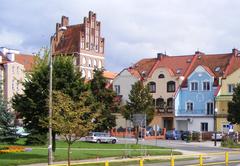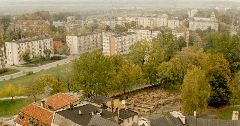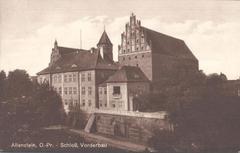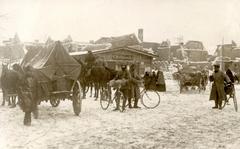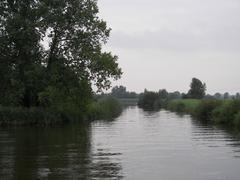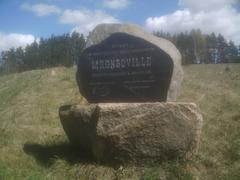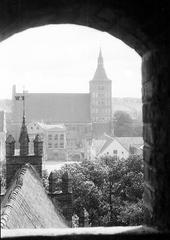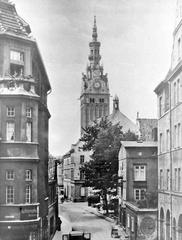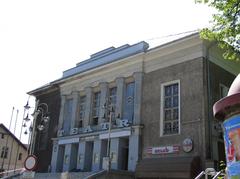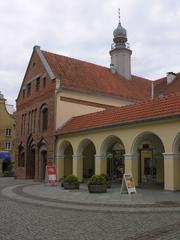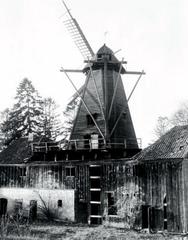
Museum of Warmia and Masuria: Visiting Hours, Tickets, and Historical Sites Guide
Date: 04/07/2025
Introduction: The Museum of Warmia and Masuria — Heritage, History, and Significance
The Museum of Warmia and Masuria, housed in the stately 14th-century Gothic Olsztyn Castle, is a gateway into the complex and fascinating past of northern Poland. Located in Olsztyn, the capital of the Warmian-Masurian Voivodeship, the museum preserves a vast array of artifacts, artworks, and manuscripts that chronicle the region’s journey through medieval times, the scientific revolution, and contemporary culture (Turturi; Museum of Warmia and Masuria Official).
Olsztyn Castle, once home to the renowned astronomer Nicolaus Copernicus, is itself a central exhibit. Copernicus’s residence from 1516 to 1521 is commemorated through displays such as his unique hand-made astronomical table and rare incunabula in the museum’s collection (web.astronomicalheritage.net). The museum’s exhibitions and educational programs reflect the rich cultural tapestry of Warmia and Masuria — shaped by Old Prussian tribes, the Teutonic Order, the Polish-Lithuanian Commonwealth, and Prussian rule (Wikipedia).
A visit to the Museum of Warmia and Masuria is enhanced by its central location in Olsztyn, close to the Old Town, Olsztyn Planetarium, and scenic lakes. This guide consolidates everything you need to plan your visit: from opening hours and ticket information to exhibition highlights and local travel tips (Lonely Planet).
Contents
- Historical Context: The Museum, Its Setting, and Regional Legacy
- Visitor Information: Opening Hours, Tickets, Accessibility
- Travel Tips & Nearby Attractions
- Copernicus at Olsztyn Castle: Scientific and Cultural Heritage
- Planning Your Visit: Facilities, Tours, Accessibility
- Visitor Experience: Programs, Highlights, and Virtual Tours
- Frequently Asked Questions (FAQ)
- Conclusion & Key Takeaways
- References
Historical Context: The Museum, Its Setting, and Regional Legacy
The Castle and Its Origins
Olsztyn Castle, an outstanding example of Gothic defensive architecture, was built in the 14th century for the Warmia Chapter’s administrators (Turturi). The castle’s most notable resident, Nicolaus Copernicus, left behind not only administrative records but also a pioneering astronomical table that remains a unique scientific artifact.
The museum was established in 1945, amidst post-war demographic and political shifts, with the mission to preserve the art, archaeology, and culture of the Warmia and Masuria regions.
Warmia and Masuria Through the Ages
The region’s story is one of cultural layering: from the Old Prussian tribes and the Teutonic Order’s theocratic rule, through integration into the Polish-Lithuanian Commonwealth and Prussia, to its modern Polish identity (Wikipedia). The museum’s collections reflect this diversity, featuring:
- Gothic sculpture and religious painting — echoing the medieval and ecclesiastical heritage.
- European art and craft — including Dutch portraits and regional pewter and bell-founding products.
- Contemporary and folk culture — documenting ongoing traditions and artistic evolution.
Olsztyn itself, set among rivers and lakes, is both an urban and natural hub, offering access to a wealth of historical and recreational sites (Explore Your Life).
Visitor Information: Opening Hours, Tickets, Facilities
Museum Visiting Hours
- Tuesday to Sunday: 10:00 AM – 5:00 PM
- Closed: Mondays and major public holidays
- Note: Hours may vary seasonally; confirm on the official museum website before your visit.
Tickets
- Adults: 15 PLN
- Reduced (students, seniors): 10 PLN
- Children under 7: Free
- Family/group rates: Available
- Purchase: At the entrance or online
- Guided tours: Additional fee; advance booking recommended
Accessibility
- The museum strives to be accessible, with wheelchair access to most exhibition areas and staff assistance upon request.
- Some historic areas, such as the tower, may be challenging for visitors with limited mobility.
Facilities
- Cloakroom and restrooms (including accessible toilets)
- Gift shop: Books, crafts, and souvenirs
- Café: Light refreshments; castle courtyard is a pleasant rest area
- Library: Rare manuscripts and incunabula
- Multilingual support: Guides and brochures in Polish, English, and German
Travel Tips & Nearby Attractions
- Best time: Spring and early autumn for fewer crowds and pleasant weather
- Nearby attractions:
- Olsztyn Old Town — historic streets, cafés, and churches
- Olsztyn Planetarium — astronomy exhibits complementing Copernicus’s legacy
- Lake Ukiel — outdoor activities
- Nature reserves and other castles in the region
- Getting there: Walk from city center, local buses (stop: “Zamek Olsztyn”), limited parking nearby
- Visitor recommendations: Allocate 1.5–2 hours for your visit; comfortable shoes advised due to uneven floors and stairs
Copernicus at Olsztyn Castle: Science and Legacy
Residency and Achievements
Nicolaus Copernicus lived at Olsztyn Castle (1516–1521, briefly in 1523) while serving as administrator and defending the region against the Teutonic Knights (web.astronomicalheritage.net). His preserved study, desk, and library offer a glimpse into his daily life and work.
The Astronomical Table (Heliograph)
A highlight of any visit is the heliograph, an astronomical instrument etched by Copernicus above his apartment entrance. Created between 1516 and 1519, the table was used to observe the Sun’s motion during equinoxes — the only surviving instrument hand-made by Copernicus (szlakkopernikowski.pl).
Exhibitions and Memorials
- Permanent exhibition: “Nicolaus Copernicus, resident of the Olsztyn Castle” — scientific instruments, personal effects, and interactive displays
- Jubilee exhibitions: Marking anniversaries, with thematic reflections on Copernicus’s work and influence
- Statues and memorials: Busts, interactive bench sculpture, and tributes in the castle park
- Olsztyn Planetarium: Opened in 1973, commemorating Copernicus’s 500th birthday, with public astronomy programs
Planning Your Visit: Facilities, Tours, Accessibility
Practical Information
- Location: ul. Zamkowa 2, 10-074 Olsztyn, Poland
- Contact: (+48 89) 527 95 96 | [email protected]
- Official website: www.muzeum.olsztyn.pl
Guided Tours and Educational Programs
- Guided tours in Polish, English, and German — focus on Copernicus, castle architecture, and regional history
- Educational workshops for children and adults on archaeology, art, and local traditions
- Multimedia displays and audio guides enhance the visitor experience
Accessibility and Visitor Conduct
- Accessible restrooms and ramps on the ground floor; some upper areas less accessible
- Supervise children, especially in towers and on stairs
- Photography allowed without flash/tripods; check with staff for restrictions
Visitor Experience: Highlights and Virtual Tours
Permanent and Temporary Exhibitions
- Copernicus Room: See the astronomical table and Copernicus’s medical incunabula (Lonely Planet)
- Archaeology: From the Stone Age to the Middle Ages — artifacts, weapons, household items
- Art collections: Gothic sculptures, Dutch portraits, folk crafts
- Numismatics: Coins, medals, rare books
Tower and Courtyard
- Castle courtyard accessible to all; tower climb (extra fee) offers panoramic city views (note: steep stairs)
Virtual Tour
- Explore key exhibits and interiors online via the museum’s virtual tour
Frequently Asked Questions (FAQ)
Q: What are the visiting hours?
A: Tuesday to Sunday, 10:00 AM – 5:00 PM; closed Mondays and major holidays.
Q: How much are tickets?
A: Adults 15 PLN, reduced 10 PLN, children under 7 free; group and family rates available.
Q: Is the museum accessible?
A: Partially; ground floor and main exhibits accessible, some historic areas may be limited.
Q: Are guided tours available?
A: Yes, in Polish, English, and German; book ahead for groups.
Q: Can I buy tickets online?
A: Yes, via the official website.
Q: What else can I see nearby?
A: Olsztyn Old Town, Olsztyn Planetarium, Lake Ukiel, nature reserves.
Conclusion and Key Takeaways
The Museum of Warmia and Masuria is a premier destination for anyone interested in Poland’s rich historical and scientific heritage. With its comprehensive collections, connection to Copernicus, and engaging programs, the museum offers insight into the diverse past and vibrant identity of Warmia and Masuria (Turturi; web.astronomicalheritage.net).
Plan your visit during spring or autumn for the best experience, and use the museum’s virtual resources to prepare or supplement your trip. Download the Audiala app for guided audio tours and up-to-date information, and follow the museum’s official channels for the latest news and events.
References
- Turturi Museum of Warmia and Masuria
- Museum of Warmia and Masuria Official Website
- Astronomical Heritage: Copernicus at Olsztyn Castle
- Lonely Planet: Museum of Warmia and Masuria
- Warmian–Masurian Voivodeship, Wikipedia


























